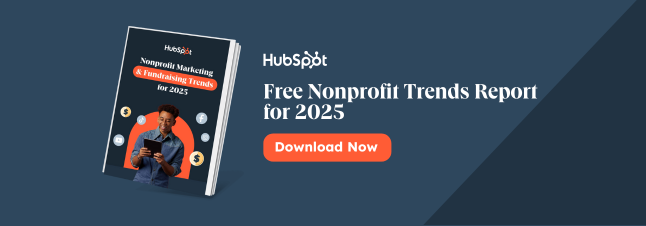Effective email and newsletter marketing is crucial for a nonprofit organization’s (NPO) success. With scarce resources, limited staffing, and divided leadership attention, investing in marketing efforts can often take a backseat to more urgent matters.

Luckily, email marketing is both cost-effective and less time-consuming than other NPO marketing strategies. Regularly sent out, well-crafted newsletters can give your nonprofit authority while also helping you stay at the forefront of your donors’ minds.
By reading this post, you will discover how your nonprofit can stay connected with donors and attract exciting new prospects through personalized and meaningful email marketing.
Table of Contents
- Why does email work for nonprofits?
- Email Marketing Best Practices For Nonprofits
- How to Write an Amazing Nonprofit Newsletter
- Examples of Nonprofit Fundraising Emails
- Free Email Marketing Software for Nonprofits
Why does email work for nonprofits?
Studies show that email continues to offer the highest return on investment (ROI) of any outreach strategy. TruConversion reports that an email marketing campaign can deliver a return of $40 for every $1 spent. This makes email the channel with the highest ROI that nonprofits can use to reach prospective donors.
Additionally, 91% of all US consumers still use email daily. Email can therefore enable NPOs to reach audiences that might not otherwise engage with their marketing efforts on social media.
Pro tip: Before starting a new email campaign, make sure it aligns with your nonprofit marketing plan and helps you reach your organization’s goals.

Email Marketing Best Practices for Nonprofits
1. Commit to regular sends.
Nonprofits are often stretched for resources, and it's easy to set marketing aside for matters that seem more pressing. However, regular email marketing is one of the most effective ways to grow your organization. A content schedule for your emails can keep you organized you can frequently engage with and steadily grow your donor base.
Making email sends an "always on" part of your marketing strategy will play a big role in your success on the channel. "Always on" doesn't mean that you're bombarding your email list with constant messages — it means that you're committed to consistency in how often you send your emails.
Send informative emails on a predictable schedule, instead of only when you're actively running a campaign or seeking donations. This will help nurture your audience towards deeper forms of engagement (like donating or attending an event) in the future. Remember: the goal is building long-term relationships.
Setting the right cadence for your emails is important to keep the members of your list engaged with your organization. When you're first starting out, this requires a careful balancing act. You don't want to send too few emails, but you also don't want to veer into potential spam territory. More on that in the next section.
Pro tip: Double-check that your email offers value to your readers before sending. Value could include the latest information about your nonprofit, ways to get involved, upcoming events, or recent projects your organization has completed.
2. Be wary of spam folders.
If your audience is only used to hearing from you on a one-off basis, you’ll need to gradually shift to sending more emails. A sudden switch could trigger some users' email clients to send you to the spam folder.
Email deliverability can be a complex subject, but here are a few important things to remember if you’re transitioning to more frequent email marketing.
- Don't directly embed forms or include attachments in your emails. Linking out to web pages with forms is a better practice.
- Send your emails from a recognizable address. If you can, avoid sending from a noreply@yourwebsite.com address. Use a name your readers will recognize.
- Lead with informative subject lines instead of direct calls for donations. Check out our blog post on picking great email subject lines.
- If you're emailing a list that isn't used to frequent sends, let them know what's going on. Tell your readers that you plan to start sending more informative emails, and most importantly, allow them to opt out. It might seem counterintuitive in the short term, but cleaning disengaged folks off your email list is important to the long-term health of your email program.
Pro Tip: Assign a staff member to send your monthly newsletter using their name. This increases your chance of avoiding donors’ spam folders.
For more tips on improving your email deliverability, check out our blog post on the subject here.
3. Leverage personal connections with your audience.
Personalizing your emails is a simple — but powerful — step that you can take to create a personal connection with readers.
First, make sure you're using an email tool that enables personalization. It might be an investment upfront, but having access to personalization features will greatly improve the value your audience gets out of your email sends.
Worried about coming off as creepy or not sure where to start? Focus on personalizing emails based on actions your email recipients have taken on your website, advises Rachel Leist, a VP of marketing, automation, and demand generation at HubSpot. Instead of using personal data in your contact management system, perhaps thank them for a donation or downloading a report.
"If a person receives an email that refers to an action they took on your website, they will not be as nervous as they would if you were personalizing around specific personal information you happen to have on them," Leist explains.
Pro tip: Personalize your emails by using first names and interesting taglines. Emails with personalized subject lines generate six times higher transaction rates.
4. Segment your database.
A segmented email list can help you ensure that the right person receives the right email at the right time. While everyone on your email list believes in your organization, you don't need to send every email to everyone. Each person in your database is at a different stage on their journey with your organization, and the emails they receive should reflect that.
For example, someone who has donated $5 to your organization in the last year is probably not as engaged as someone who has donated $1,000 to your organization in the last month.
Factors like donation amount, events attended, and actions taken on your website or social media channels can all be important indicators of engagement level, and shouldn't be ignored when you're sending out emails.
More engaged audience members will likely respond more positively to more frequent emails, while folks with fewer touch points should receive fewer emails giving them more basic information about your NPO.
Pro tip: When people download your content or subscribe to your newsletter, make sure you enter them into a specific drip campaign that sends them automated emails relevant to the topics they are interested in.
5. Test, analyze, and adapt accordingly.
Finally, running an email program is not a "one-and-done" marketing strategy. You’ll need to note key performance indicators and make changes to your approach based on real-world data.
If you’re just getting started, industry benchmarks can be a useful point of comparison. But remember, not all NPOs are the same, and not all NPO audiences are going to respond the same way to emails.
To start, keep track of a few key email metrics, measure them with each email send, and look for trends over time. Our article on email marketing metrics for beginners offers a helpful starting place if you're not sure what to track.
Pro tip: Regularly monitor your email open rate using the Hubspot email health tool.
How to Write an Amazing Nonprofit Newsletter
1. Write an eye-catching subject line.
Subject lines can be tricky. You’re looking for a short phrase that communicates your intent while retaining your non-profit’s unique voice. An interesting subject line should include the following elements.
- Urgency. You want recipients to feel the urgency to both open emails from your NPO and take action.
- Specificity. If you have an interesting statistic or data point to share, be sure to put it in the subject line.
- Upcoming events. To increase engagement, your newsletter should let people know what upcoming events they can attend or volunteer at.
- Name recognition. Pique your audience’s interest by including their name in the subject line (when appropriate).
- Relevancy. If current events or politics influence your nonprofit’s goal(s), referencing those events can make your newsletter more relevant and timely.
Pro tip: 46% of email opens take place on mobile, so be sure to make your subject lines 50 characters or less so mobile viewers can read the entire message.
Explore this blog for more subject line best practices.
2. Give compelling updates.
An amazing nonprofit newsletter should include the latest and greatest from your organization. Inform your recipients of recent goals reached, heartwarming stories of those you help, life updates of staff and volunteers, and anything else of note.
Pro tip: To make your emails visually interesting, take pictures during events to include in your newsletters. With permission, include the names of the volunteers pictured and describe what activities took place.
3. Have an attitude of gratitude.
Your cause is near and dear to those who subscribe to your newsletter. Their time spent volunteering and money donated should always be received with a spirit of gratitude.
Let email recipients know the immediate impact of their donations with interesting data points. For example, “Your donation helped x number of families” or “Your volunteer efforts fed x number of children.”
Pro tip: Some of your newsletter recipients will be more involved than others. Consider opening the line of communication with these donors by sending a personalized, non-automated email that references their specific efforts to the cause.
4. Include a Call-to-Action
A call-to-action (CTA) is an invitation to your audience to do something. In an email or newsletter, your CTA should be a button that links to the action you want recipients to take next.
Examples of CTAs for your nonprofit email could be “Subscribe to the newsletter,” “Donate now,” “Refer a friend,” or more. Don’t be afraid to get creative with your CTAs, and be sure to measure your conversion rate.
Pro tip: There are lots of CTA tools you can use to make linking to the next step easier. Explore common options here.
Examples of Nonprofit Fundraising Emails
Want to put together an effective fundraising email? Check out some examples to get a sense of what your newsletter can look like.
Alzheimer's Association
This Welcome email from the Alzheimer's Association doesn’t lead with a request for a donation. Instead, the team connects recipients to the cause by providing them with resources to learn about the disease.
The main CTA urges readers to “learn the facts.” By gaining a greater understanding of Alzheimer’s email recipients are encouraged to act — either by advocating for the group, volunteering, or donating.
What we love: There are several resources shown in this email, targeting different groups affected by Alzheimer’s disease. A loved one could access a support group. A family looking for care solutions can explore their options. Most importantly, people living with Alzheimer’s are given autonomy and can get matched with a care team.

Black Girls Code
This email from Black Girls Code focuses on one webinar that is open to all. By including events and participation opportunities, the nonprofit demonstrates value to those on its email list. As a subscriber, you’ll make sure you never miss an event.
What we love: This email utilizes design to strategically focus readers’ attention. The graphic that includes the panel’s speaker information and time are beautifully designed with eye-catching colors that pop over a black background. The only other colorful elements? Two bold registration CTAs in lavender.

The End Child Poverty California Coalition (ECPC)
ECPC’s email demonstrates the importance of keeping your donors and volunteers informed. This section of the group’s newsletter explains how much the coalition’s Imagine Campaign secured and where funds were used. An infographic makes understanding the complexities of state budgeting easy.
What we love: ECPC has mastered transparency. The group acknowledges that not all of its priorities were included in the state budget. After, the coalition celebrates wins they were able to achieve. The use of honesty makes the nonprofit feel trustworthy and garners even more support.

The Trevor Project
Awareness days, holidays, and important anniversaries offer special opportunities to engage your audience. This is especially true when you can tie the event to your nonprofit’s mission or research.
The Trevor Project sent a dedicated email on Intersex Awareness Day. In the email, the organization explains what it means to be intersex and the importance of acknowledging this community. Then, it links to a report where people can learn more about the well-being of intersex youth.
What we love: Not only does this email highlight Intersex Awareness Day, it also reminds recipients that October is LGBTQ History Month. Readers who didn’t have their calendars marked are now informed and will be more likely to engage with other Trevor Project research.

The International Rescue Committee
The International Rescue Committee (IRC) faces the urgent task of assisting people in conflict zones and disaster areas. This email both explains what the organization does and its historical impact.
What we love: Highlighting articles and the organization’s history increases the subscriber’s emotional investment. Readers will also have a better understanding of the IRC’s values.

The Smithsonian Institution
The Smithsonian Institution is one of the largest museum and research networks in the world. Keeping up with each museum and department would be exhausting. Luckily, the nonprofit’s marketing team has gathered the highlights into one, easy-to-read newsletter.
What we love: When we go to museums, we marvel at the artifacts and objects on display. The Smithsonian newsletter uses photographs to replicate this experience on any device.

Save The Children
When folks first sign up for your emails, it's a good indicator that they're feeling engaged with your mission. Check out this automatic welcome email from Save the Children introduces the organization to a new subscriber and requests a donation at the end. Your audience wants to help — don't make them wait!
What we love: Save the Children created a simple infographic to show how a small donation can make a big impact. This can encourage supporters to contribute.

Citizens’ Climate Lobby
Citizens’ Climate Lobby (CCL) demonstrates in the email below how to update subscribers on important current events. By referencing recent policy changes that were helpful to their cause, CCL can both thank their email subscribers for their hard work while getting them excited about future progress.
What we love: This email does a good job of providing relevance and timeliness to the nonprofit’s conversation. 
826 Boston
826 Boston is a writing, tutoring, and publishing nonprofit that works with students and community members. As a local nonprofit, community events offer an opportunity for Boston residents to get involved and learn more about the organization. This email highlights Books for Breakfast, including critical information about where the event is held and when.
Pro tip: If your organization relies on donations from corporate sponsors, email offers an opportunity to showcase your partnership. This creates added value for the businesses you work with.

Wikimedia
Not every donor or subscriber should be emailed every day. Wikimedia is sparing with its calls for donations, making their infrequent sends more impactful. By highlighting a past action and demonstrating urgency for a repeat donation, recipients will be more likely to give.
This type of email works best for past donors and less active members of your email list. Even though they don’t visit your website daily, they may be willing to donate on occasion.
What we love: This email from Wikimedia shows what percentage of your donation goes to which parts of the organization. This creates transparency and makes donors feel good about their contributions.

Free Email Marketing Software for Nonprofits
Want to use professional email software for your nonprofit without breaking the bank? There are several free versions of professional marketing software that you can use. Check out what some of the most popular programs offer. Then, decide which option works best for you.
1. HubSpot Email Marketing Software
HubSpot offers a free version of its paid email marketing software that integrates with its free CRM software. Users can run a sophisticated marketing campaign and get access to forms, landing pages, and Facebook, Instagram, Google, and LinkedIn ads, as well as templates.
HubSpot also has access to contact management and live chat capabilities. These tools allow you to optimize the experience for each subscriber. There are also traffic and conversion analytics capabilities for campaign optimization.
2. Sender
Want to reach lots of people with beautiful, personalized emails? Sender could be just right for you. This program has extensive HTML editing and personalization capabilities. Sender also has impressive analytics capabilities that allow you to track the delivery and opening of individual emails. You’ll also be able to build individual recipient profiles to further optimize your strategy.
3. Sendinblue
If you're looking for variety in your emails, Sendinblue has you covered. This program includes over 70 responsive templates for emails that can be designed for any screen. The free version gives you the ability to send 300 emails a day.
You also have the ability to use A/B testing to find email content that works and segmenting options to make sure the right person receives your message.
4. SendGrid
SendGrid specializes in email campaigns that are tailored to individual preferences. Its free version gives you access to a wide range of personalization tools, including APIs, Webhooks, and STMP Relay.
You'll also have granular control over who receives your emails with a wide range of delivery optimization tools. Plus, you can access sophisticated email editing and analytics tools that allow you to optimize sends for your target audience.
Start Today
You don't need to be a professional marketer to get professional results from email marketing. However, you do need to set some time aside to get started.
Remember, email marketing when done thoughtfully, can have a big payoff. Get started today if you haven't already, and you could generate more buzz for your organization than ever before!
![Download Now: Nonprofit Marketing & Fundraising Trends for 2022 [Free Report]](https://no-cache.hubspot.com/cta/default/53/6193b715-2ba9-4c6d-add0-681edfcae689.png)







![A Quick Guide to Nonprofit Website Redesigns [+Best Practices]](https://www.hubspot.com/hubfs/nonprofit%20website%20redesign-1.jpg)


